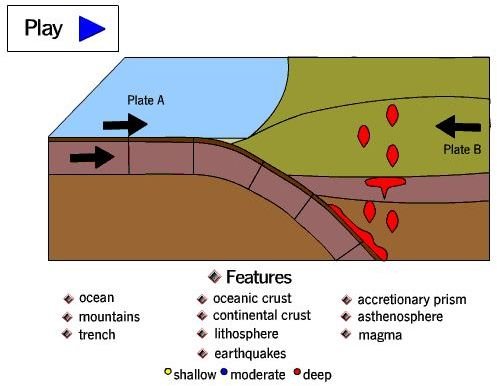A Deep Sea or Oceanic Trenches Definition: What Are They?
Plate Tectonics & Deep Sea Trenches
Plate tectonics, the movement of the plates that form the crust of the planet, is driven by convective currents in the magma of the Earth’s mantle. The friction between these currents and the relatively hard lithospheric crust above it causes the crust to move with the currents. Where two currents converge, two crusts also converge. Instead of simple piling into each other, the denser of the two subducts beneath the more buoyant of the two.
Oceanic crust consists of mafic rocks, such as basalt and gabbro, which is inherently more dense than continental crust, which consists of felsic rocks such as granite or pegmatite. Thus, oceanic crust tends to get subducted beneath continental crust. Two oceanic crusts may also converge, which simply leads to the denser of the two subducting beneath the other. This creates a long, narrow, and deep depression along the boundary known as a deep sea or oceanic trench.
Basic Subduction Diagram
Trenches, Volcanos & Earthquakes, Oh My!
These convergent boundaries are home to some of the most spectacular—and damaging—geologic instability on the planet.
As the lithospheric crust sinks, it also raises the level of the crust it is subducting beneath, leading to high mountain ranges along that side of the margin. Helping this along is the increase of volcanic activity along the margin, created as the subducting plate melts into the hot mantle, leading to often explosive volcanic island arcs such as Japan or the Philippines.
The process of subduction also triggers very deep earthquakes, up to 700 km beneath the surface of the Earth. Think about some of the most damaging earthquakes in our times, such as the 2006 Java earthquake that triggered a tsunami that killed hundreds of people and displaced thousands more, or the 2004 Indian Ocean tsunami that resulted in upwards of 200,000 dead.
So, while deep sea trenches in and of themselves do not cause this damage, the processes that create them also create incredible turmoil for life on the surface.
Filled Trenches
However, not all deep sea trenches actually appear to be trenches at first glance. Most trenches fill with sediment, particularly those located near continental margins where rivers wash out sediment into the sea—and into the trench. Formations such as submarine canyons and turbidity currents may form, in much the same way as they do off of continental shelves. Also, as the crust subducts, much of the surface sediment is literally scraped off the top of it in a bulldozer fashion and instead piles into the trench. This filling is known as an accretionary prism.
Those subduction zones that proceed along slowly tend to fill with sediment more easily, as opposed to those which subduct at faster rates.
Examples
But where are deep sea (oceanic) trenches located? The majority are found around the margins of the Pacific Ocean. For this reason, the Pacific Ocean is slowly shrinking. Some examples include the Peru-Chile trench running most of the length of western South America, the Alaskan-Aleutian trench, the Cascadia trench alongside British Columbia, Washington and Oregon, the Japan trench, and others.
The deepest place indentation into the surface of the Earth is found in a deep sea trench, specifically, the Mariana Trench just to the east of the Philippines. This location is known as Challenger Deep, located at a dept of 10,911 meters (35,798 feet) below sea level.
However, there are oceanic trenches elsewhere in the world. For instance, the Puerto Rico trench, which begins on the east margin of Cuba, runs by Puerto Rico and further south along the margin between the Caribbean and Atlantic plates. In the Mediterranean, there is a small subduction zone south of Crete, represented by the Hellenic trench.
